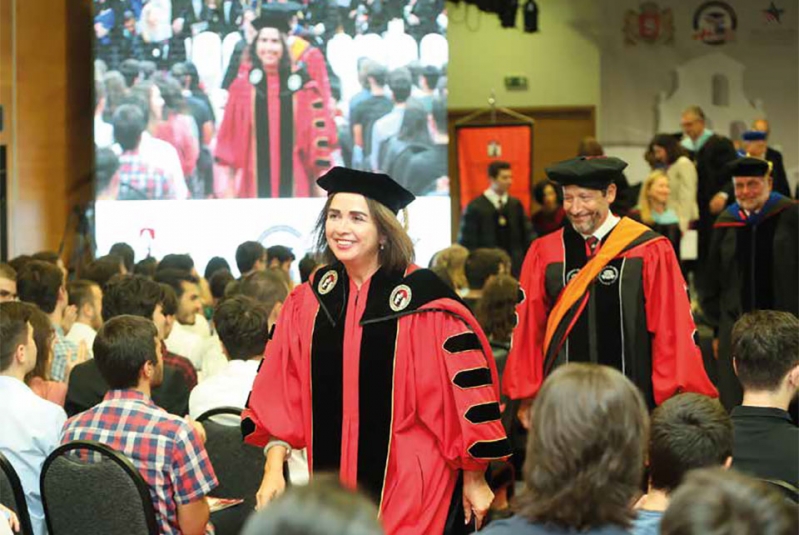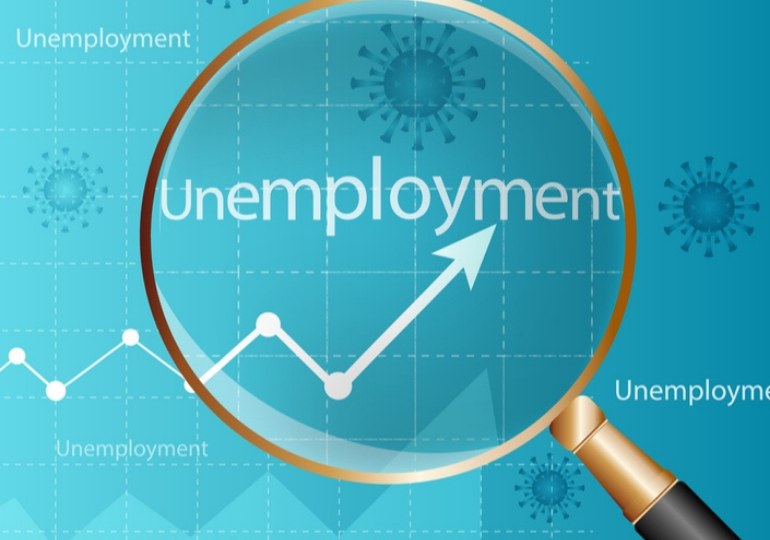San Diego State University is one of the world’s leading public research institutions and has a legacy that dates back more than 121-years. Over the past four years SDSU has managed to become one of the most successful, most desired universities on the Georgian educational market. This can be demonstrated by the passion SDSU Georgia students have for STEM (Science, Technology, Engineering and Mathematics) and their new university. Since 2015, through funding from the U.S. government’s Millennium Challenge Corporation, SDSU offers Bachelor of Science programs in all four STEM fields. SDSU Georgia students are able to earn a professionally accredited, internationally-recognized U.S. bachelor’s degree, which will prepare them to be competitive professionals in their fields. This year SDSU accepted 230 students into its internationally accredited American degree programs in Georgia and welcomed them at their annual New Student Convocation Ceremony. This exciting event was attended by the new president of San Diego State University, Dr. Adela de la Torre. This is President de la Torre’s first visit to Georgia, and Forbes magazine was thrilled to meet her and discuss the main achievements of SDSU in Georgia.
San Diego University has been offering STEM programs in Georgia for four years. This program has already become one of the most popular universities in the country, attracting some of the highest ranking students according to their national exam scores. As its popularity grows each year, can you share with us what it is that makes this program so attractive?
I think there are number of reasons why students want to attend the SDSU Georgia STEM program. First of all, San Diego State University is one of the top research institutions in United States. In fact, it has been ranked as one of the top 60 public institutions in the United States. SDSU Georgia also provides a unique opportunity for students to earn two degrees – one Georgian and one U.S. degree. Finally, STEM fields are valuable for both the student’s career, as well as the economic development of the Georgia. At SDSU Georgia, we are proud to offer opportunities to study computer science, computer engineering, biochemistry and chemistry as well as civil, construction and electrical engineering. These fields are highly desired by domestic and international companies. For example, one of our exceptional students participated in our exchange program and studied in San Diego, California. While there, he participated in two internships with Google and Facebook. In the end, he decided to work with Facebook and has the opportunity to bring his new skills and knowledge to Georgia and work as an entrepreneur. Now, this is a rare opportunity, even in the U.S., but another rare opportunity is the chance for Georgian students to earn an American degree within their own country. With this degree comes great internships and job opportunities that can help students build successful careers while helping their country prosper. All students who participate in the exchange program have the opportunity to spend a semester or more studying in the United States. The curriculum is completely transferable, so it will not delay graduation.
In your opinion what are the main achievements of San Diego State University and its STEM program in Georgia?
Well, I think we have been very successful over the last few years increasing involvement and interest in STEM here in Georgia. This is important because after the collapse of the Soviet Union, the STEM area really needed to be built-up. We brought our faculty from San Diego to Georgia in order to work closely with Georgian faculty to cross train them in these fields. Another area of success is infrastructure development at our Georgian partner universities to develop a new state of- the-art university building, as well as outfitting chemistry and engineering laboratories with best equipment in the South Caucasus. Additionally, we are proud to introduce internationally recognized certification programs for our engineering programs. With engineering, as in chemistry, you must have a certification to ensure you make an international impact. Finally, we are proud of the work we’ve done with the support of both the American and Georgian governments to make sure that the faculty, equipment, and requirements for certification are here in Georgia. To sum up, we’ve not only built infrastructure, but we have also built a pipeline for our students. By doing so we have created a long lasting relationship between the institutions of higher education here in Georgia and in the U.S. through San Diego State University.
You mentioned that you have good cooperation with the public and private sector – both domestic and American. What you can say about the role of public private partnership?
We’ve been able to raise over $3 million through private and public donors to help provide additional scholarships. Our scholarship funding comes from many successful organizations, such as Bank of Georgia, GPF, Georgian Water and Power, GIG, Silknet, GDI, GMP, Adjara Group, TBC Bank and our biggest donor, the Cartu Foundation, who all chose to invest in our students. It is important to understand that unlike the U.S., many students, particularly those who do not have the same economic capacity with their families, require full funding and cannot pay tuition. It’s through the partnerships we’ve developed that we have been able to provide additional scholarships for many students, including those who come from very remote parts of Georgia, ethnic minority groups, and other students who come from a very humble background. These students receive a full scholarship to attend this very important and groundbreaking program within the country of Georgia.
Let’s discuss the issue of employment which, as we know, is a very important topic. When a student graduates from a university such as SDSU, how can you guarantee they will find a job?
Well, many individuals through the internships will get jobs. Globally, there is a high demand for construction management and engineering, so those students within those fields are likely to get a job before they leave the program. Domestically, if you look at the infrastructure around Georgia, there is a clear need to have talented engineers to help with infra structure development. In areas of computer science throughout Georgia and in the U.S., the demand is very high. You need to have individuals who are well trained both in engineering and computer science. So those students that I’ve mentioned above will get good jobs. As for biochemistry, that is an important area because if you think of biotech, and anything dealing with pharmacy, they require the capacity of individuals who are well trained. The quality of training SDSU Georgia students are going to receive at the bachelor’s level will be important for the industry. Therefore, we are very optimistic about our first class graduating in June who will be either going into the job market or applying for a graduate program to obtain a doctoral degree. There will be some students who plan to continue with San Diego State as doctoral students in a number of our programs.
At the beginning of the interview you mentioned an exchange programs between the U.S. and Georgia. Let’s talk in detail about these visits between the two countries. What kind of opportunities does San Diego State University offer to Georgian students?
Because these students are San Diego State University students in Georgia they can take classes at our main campus San Diego, California. Any of the students from our program can attend and go to the U.S. to participate in classes in their field because the faculty at SDSU have developed courses here in Georgia. Therefore, there is complete reciprocity between the two campuses. Students can stay for the semester or some may choose to stay for a year in order to complete internships and take advantage of the same opportunities given to our American students.
When we think about STEM, we imagine a male dominated field. However, statistics show that almost forty percent of San Diego State University Georgia Students are female. What are your thoughts on this surprising statistic?
Well, we are very much excited about the fact that 40% of our students in STEM are women. Many of them perform better than their male counterparts. I think this is a credit to how we have been able to develop outreach programs with schools throughout the country. In Georgia women are equally, or more capable in STEM. So, I’m not surprised that Georgian women are incredibly talented in mathematics and have an interest in STEM-related fields. During my visit, I met a group called “Empower Women San Diego State University in Georgia” and this is a group of women who are in our program who want to make sure that they have every opportunity in Georgia to become influential leaders in the field of STEM and compassionate leaders for the future of this country. We are proud to have these leaders as part of our program.
What are the main skills that this university, and in particular this STEM program, gives to its students?
Beyond the specific skills in the discipline, which of course are very important in the STEM field, we also require students to have a general education. This enables them to fully understand the importance of world history, how to become leaders, ethical innovators, and global citizens. All of these are important attributes of San Diego State University graduates. In addition, we also want to make sure we assist them with professional development skills so they are career ready in whatever field or industry they choose.
I also want to talk with you about future plans of San Diego State University in Georgia, because as I understand, this system not only works but it works very well.
During our visit we brought important deans and faculty members. This included our Dean of Sciences, Dean of Engineering, Chair of Chemistry and Biochemistry, Chair of Computer Sciences, and Chair of Electrical and Computer Engineering, and lastly the Chair of Civil and Construction Engineering. These faculties are working to see how we can create an opportunity to continue this great work. Some of it will be through the partnerships with Georgian faculty. One of the big goals was to get the faculty from different fields at a level where they can be internationally accredited. We are currently in the process of completing this objective. In addition, we want to move forward with joint research projects. We want to see how we can bring some students from this program into our doctoral programs. We’re also looking at opportunities in which we can further develop programs that can support other programs that might emerge with San Diego State as well. The advisory committee will be coming out in April so we can discuss the pathways on which we can build a future long term relationship with our sister institutions here in Georgia.
To sum up, which stage of development is SDSU at today and what kind of role does it have in the Georgian educational system?
I think we’ve been very fortunate that the Millennium Challenge Corporation through the Millennium Challenge Account Georgia has supported this particular initiative and we’ve had such strong support from the governments of United States and Georgia. We have also had strong philanthropic support from private donors for the program. It is taking us a while to get to the point where now there is a national recognition of the significance of this program, and I think that means there is going to be a positive trajectory for this program in the future. My hope is,as we begin to plan for the future, particularly the private sector in Georgia, the philanthropic community begins to invest even more in higher education. I think the future of this country is based on investing in the youth because as you invest in youth education, you also impact productivity. Georgia, like many countries throughout the world, is suffering from an age profile where many people are retiring without investing in the productivity of the youth. When this happens, you are going to have an imbalance in the economy, which is not feasible in any country. So our pathos is that it has to really focus and ask ourselves how do we engage the youth, how do we engage them to go into fields of importance and how do we create a salary structure that’s going to keep them here so they don’t choose to leave the country. Because the other issue is that if you don’t increase salary levels, young people will leave. They will go somewhere else where they feel that they can earn higher wages. So this is very important and pivotal moment for Georgia.

Forbes Georgia
"Forbes Georgia-ის სარედაქციო ბლოგპოსტების სერია "როგორ გამდიდრდა“ და "საქართველო რეიტინგებში".













